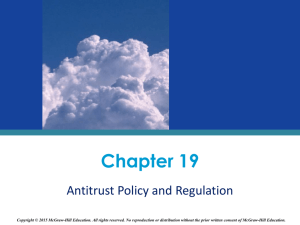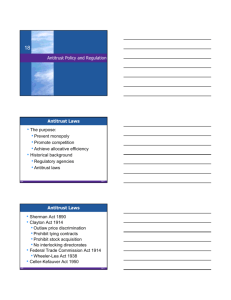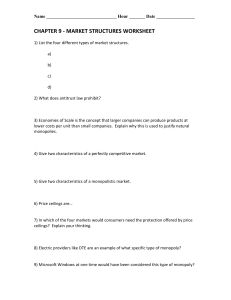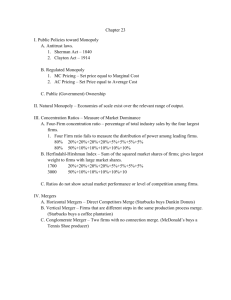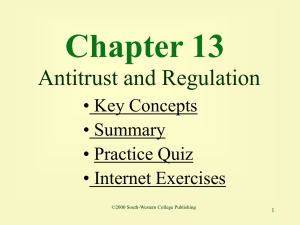Document
advertisement
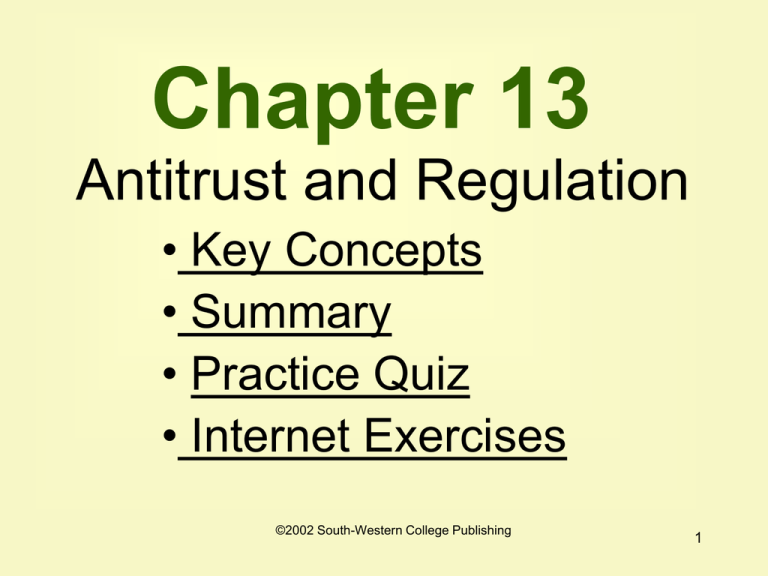
Chapter 13 Antitrust and Regulation • Key Concepts • Summary • Practice Quiz • Internet Exercises ©2002 South-Western College Publishing 1 What is a trust? A combination or cartel consisting of firms that place their assets in the custody of a board of trustees 2 What is predatory pricing? The practice of one or more firms temporarily reducing prices in order to eliminate competition and then raising prices 3 When was the age of the robber barons? In the later part of the 1800’s 4 What was done to limit the power of trusts? Congress passed laws aimed at preventing firms from engaging in anticompetitive activities 5 What is the Sherman Act? The federal antitrust law enacted in 1890 that prohibits monopolization and conspiracies to restrain trade 6 What is the Clayton Act? A 1914 amendment that strengthens the Sherman Act by making it illegal for firms to engage in certain anticompetitive business practices 7 What business practices were declared illegal under the Clayton Act? • Price discrimination • Exclusive dealing • Tying contracts • Stock acquisition of competing companies • Interlocking directorates 8 Was the Clayton Act an improvement over the Sherman Act? Although more specific than the Sherman Act, the Clayton Act is also vague 9 What is the Federal Trade Commission Act? The federal act that in 1914 established the Federal Trade Commission (FTC) to investigate unfair competition 10 What is the Robinson-Patman Act? A 1936 amendment to the Clayton Act that strengthens the Clayton Act against price discrimination 11 What is the basic purpose of the Robinson-Patman Act? To prevent large sellers from offering different prices to different buyers where the effect is to harm even a single small firm 12 What is the Celler-Kefauver Act? A 1950 amendment to the Clayton Act that prohibits one firm from merging with a competitor by purchasing its physical assets if the effect is to substantially lessen competition 13 What are some key antitrust cases? • Standard Oil Case 1911 • Alcoa Case 1945 • IBM Case 1982 • AT&T Case 1982 • MIT Case 1992 • Microsoft Case 1995 14 What was the outcome of the standard oil case? The rule of reason 15 What is the rule of reason? The antitrust doctrine that the existence of monopoly alone is not illegal unless the monopoly engages in illegal business practices 16 What was the outcome of the Alcoa case? The per se rule 17 What is the per se rule? The antitrust doctrine that the existence of monopoly alone is illegal, regardless of whether or not the monopoly engages in illegal business practices 18 What was the result of the IBM case? A switch back to the rule of reason 19 What was the result of the AT&T case? Technology made this government-regulated natural monopoly obsolete, and AT&T was found guilty of anticompetitive pricing 20 What was the result of the MIT case? Eight Ivy League schools agreed to stop colluding to fix prices, and MIT was found guilty of price fixing 21 What was the result of the Microsoft case? Microsoft was not allowed to purchase Intuit Inc., a competitor in the personal finance software industry 22 What was the Microsoft case of 2001? This case charged Microsoft with predatory pricing by tying its monopoly in Windows to its Internet Explorer browser 23 How can firms avoid charges of price fixing? They can merge into one company 24 When did a lot of mergers begin taking place? In the 1980’s 25 What are the different types of mergers? • Horizontal • Vertical • Conglomerate 26 What is a horizontal merger? A merger of firms that competes in the same market 27 What is a vertical merger? A merger of a firm with its suppliers 28 What is a conglomerate merger? A merger between firms in unregulated markets 29 What can be said about conglomerate mergers? They are generally allowed because they do not significantly decrease competition 30 What can be said about antitrust laws in other countries? They are weak in comparison to U.S. antitrust laws 31 What is the history of government regulation? From the later part of the 1800’s to the 1970’s, there was an increase in regulation; in the 1970’s there was a movement away from regulation 32 What is the basic argument in favor of government regulation? Market failure 33 In what ways does the market fail? • Natural monopoly • Externalities • Imperfect information 34 What is a natural monopoly? An industry in which longrun average cost is minimized when only one firm serves the market 35 What is marginal cost pricing? A system of pricing in which the price charged equals the marginal cost of the last unit produced 36 P $50 $40 $30 $25 $20 $15 $10 $5 Regulated Monopoly Fair return price efficient price A B MR C 1 2 3 4 5 6 7 LRAC LRMC D Q 8 9 37 What is a normal profit? The accounting profit required to induce a firm’s owners to employ their resources in the firm 38 Do production costs include normal profit? Yes, because normal profit is considered a necessary expense of a business 39 What kind of profit is made at the fair return price? Normal Profit 40 What happens when pollution is present? Pollution causes polluting firms to overproduce, while causing firms that pay the cost of cleaning up the pollution to underproduce 41 What can be done when the externality of pollution is present? The government can regulate the industry to minimize the pollution 42 What happens with imperfect information? Deficient information on unsafe products can cause consumers to overconsume a product 43 P $20 Impact of Imperfect Information S E1 $15 E2 $10 D1 $5 D2 25 50 75 100 Q 44 Decrease in quantity supplied Increase in Demand Consumers informed of defect 45 Key Concepts 46 Key Concepts • • • • • • • • • What is a trust? What is predatory pricing? What is the Sherman Act? What is the Clayton Act? What is the Federal Trade Commission Act? What is the Robinson-Patman Act? What is the Celler-Kefauver Act? What is the rule of reason? What is the per se rule? 47 Key Concepts cont. • • • • • What are the different types of mergers? What is a horizontal merger? What is a vertical merger? What is a conglomerate merger? What can be said about antitrust laws in other countries? • What is a natural monopoly? • What happens when pollution is present? • What happens with imperfect information? 48 Summary 49 A trust is a cartel that places the assets of competing companies in the custody of a board of trustees. During the last decades of the 19th century, trusts engaged in anticompetitive strategies to eliminate competition and raise prices, such as predatory pricing. 50 The Sherman Act of 1890 and the Clayton Act of 1914 are the two most important antitrust laws. The Sherman Act marked the first attempt of the U.S. government to outlaw monopolizing behavior. Because this act was vague, the Clayton Act was passed to define anticompetitive behavior more precisely. 51 The Clayton Act prohibited (1) price discrimination, (2) exclusive dealing, (3) tying contracts, (4) stock acquisition, and (5) interlocking directorates. 52 The Robinson-Patman Act of 1936 strengthened the Clayton Act by prohibiting certain forms of price discrimination. This law is called the “Chain Store Act” because it was aimed at large retail chain stores that were obtaining volume discounts. 53 The Celler-Kefauver Act of 1950 strengthened the Clayton Act declaring illegal the acquisition of the assets of one firm by another firm if the effect is to lessen competition. 54 The rule of reason and the per se rule are the two main philosophies the courts have used in interpreting antirust law. Under the rule of reason, monopolist were not subject to prosecution unless they acted in an anticompetitive manner. 55 The Supreme Court decision in the Alcoa case of 1945 replaced the rule of reason with the per se rule, which states that the mere existence of monopoly is illegal. Today, the trend is in favor of dominant firms because of international competition. 56 A horizontal merger is a merger of two competing firms. A vertical merger is a merger of two firms where one produces an input used by the other firm. A conglomerate merger is a merger of two firms producing unrelated products. 57 Deregulation is a movement that began in the1980’s to eliminate regulations primarily in the transportation and telecommunications industries. Today, the current trend is toward further deregulation resulting from federal budget cuts. 58 Marginal cost pricing is a competitive pricing strategy for a regulated natural monopoly. Using this approach, regulators set the monopolist’s price equal to its marginal cost. Another method is for regulators to establish a fairreturn price equal to long-run average cost and the monopolist earns zero economic profit. 59 Regulation of a natural monopoly is justified on the basis of market failure. Two other cases based on market failure include externalities and imperfect information. 60 P $50 $40 $30 $25 $20 $15 $10 $5 Regulated Monopoly Fair return price efficient price A B LRAC MR C 1 2 3 4 5 6 7 LRMC D 8 9Q 61 END 62

